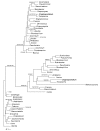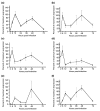Phylogenomic evidence supports past endosymbiosis, intracellular and horizontal gene transfer in Cryptosporidium parvum
- PMID: 15535864
- PMCID: PMC545779
- DOI: 10.1186/gb-2004-5-11-r88
Phylogenomic evidence supports past endosymbiosis, intracellular and horizontal gene transfer in Cryptosporidium parvum
Abstract
Background: The apicomplexan parasite Cryptosporidium parvum is an emerging pathogen capable of causing illness in humans and other animals and death in immunocompromised individuals. No effective treatment is available and the genome sequence has recently been completed. This parasite differs from other apicomplexans in its lack of a plastid organelle, the apicoplast. Gene transfer, either intracellular from an endosymbiont/donor organelle or horizontal from another organism, can provide evidence of a previous endosymbiotic relationship and/or alter the genetic repertoire of the host organism. Given the importance of gene transfers in eukaryotic evolution and the potential implications for chemotherapy, it is important to identify the complement of transferred genes in Cryptosporidium.
Results: We have identified 31 genes of likely plastid/endosymbiont (n = 7) or prokaryotic (n = 24) origin using a phylogenomic approach. The findings support the hypothesis that Cryptosporidium evolved from a plastid-containing lineage and subsequently lost its apicoplast during evolution. Expression analyses of candidate genes of algal and eubacterial origin show that these genes are expressed and developmentally regulated during the life cycle of C. parvum.
Conclusions: Cryptosporidium is the recipient of a large number of transferred genes, many of which are not shared by other apicomplexan parasites. Genes transferred from distant phylogenetic sources, such as eubacteria, may be potential targets for therapeutic drugs owing to their phylogenetic distance or the lack of homologs in the host. The successful integration and expression of the transferred genes in this genome has changed the genetic and metabolic repertoire of the parasite.
Figures






Similar articles
-
A first glimpse into the pattern and scale of gene transfer in Apicomplexa.Int J Parasitol. 2004 Mar 9;34(3):265-74. doi: 10.1016/j.ijpara.2003.11.025. Int J Parasitol. 2004. PMID: 15003488
-
Reduction and compaction in the genome of the apicomplexan parasite Cryptosporidium parvum.Dev Cell. 2004 May;6(5):614-6. doi: 10.1016/s1534-5807(04)00135-2. Dev Cell. 2004. PMID: 15130487 Review.
-
Evolutionary origins of the eukaryotic shikimate pathway: gene fusions, horizontal gene transfer, and endosymbiotic replacements.Eukaryot Cell. 2006 Sep;5(9):1517-31. doi: 10.1128/EC.00106-06. Eukaryot Cell. 2006. PMID: 16963634 Free PMC article.
-
Characterization of a mitochondrion-like organelle in Cryptosporidium parvum.Parasitology. 2004 Jul;129(Pt 1):1-18. doi: 10.1017/s003118200400527x. Parasitology. 2004. PMID: 15267107
-
After the primary endosymbiosis: an update on the chromalveolate hypothesis and the origins of algae with Chl c.Photosynth Res. 2011 Jan;107(1):103-15. doi: 10.1007/s11120-010-9584-2. Epub 2010 Jul 30. Photosynth Res. 2011. PMID: 20676772 Review.
Cited by
-
Ancient gene transfer from algae to animals: mechanisms and evolutionary significance.BMC Evol Biol. 2012 Jun 12;12:83. doi: 10.1186/1471-2148-12-83. BMC Evol Biol. 2012. PMID: 22690978 Free PMC article.
-
Horizontal gene transfers with or without cell fusions in all categories of the living matter.Adv Exp Med Biol. 2011;714:5-89. doi: 10.1007/978-94-007-0782-5_2. Adv Exp Med Biol. 2011. PMID: 21506007 Free PMC article. Review.
-
Red and problematic green phylogenetic signals among thousands of nuclear genes from the photosynthetic and apicomplexa-related Chromera velia.Genome Biol Evol. 2011;3:1220-30. doi: 10.1093/gbe/evr100. Epub 2011 Sep 28. Genome Biol Evol. 2011. PMID: 21965651 Free PMC article.
-
The scale and evolutionary significance of horizontal gene transfer in the choanoflagellate Monosiga brevicollis.BMC Genomics. 2013 Oct 25;14(1):729. doi: 10.1186/1471-2164-14-729. BMC Genomics. 2013. PMID: 24156600 Free PMC article.
-
Overexpression of a cytosolic pyrophosphatase (TgPPase) reveals a regulatory role of PP(i) in glycolysis for Toxoplasma gondii.Biochem J. 2011 Dec 1;440(2):229-40. doi: 10.1042/BJ20110641. Biochem J. 2011. PMID: 21831041 Free PMC article.
References
-
- CDC: bioterrorism agents/diseases http://www.bt.cdc.gov/agent/agentlist.asp
-
- Zhu G, Keithly JS, Philippe H. What is the phylogenetic position of Cryptosporidium? Int J Syst Evol Microbiol. 2000;50:1673–1681. - PubMed
-
- Carreno RA, Martin DS, Barta JR. Cryptosporidium is more closely related to the gregarines than to coccidia as shown by phylogenetic analysis of apicomplexan parasites inferred using small-subunit ribosomal RNA gene sequences. Parasitol Res. 1999;85:899–904. doi: 10.1007/s004360050655. - DOI - PubMed
Publication types
MeSH terms
Substances
Grants and funding
LinkOut - more resources
Full Text Sources
Other Literature Sources
Miscellaneous

